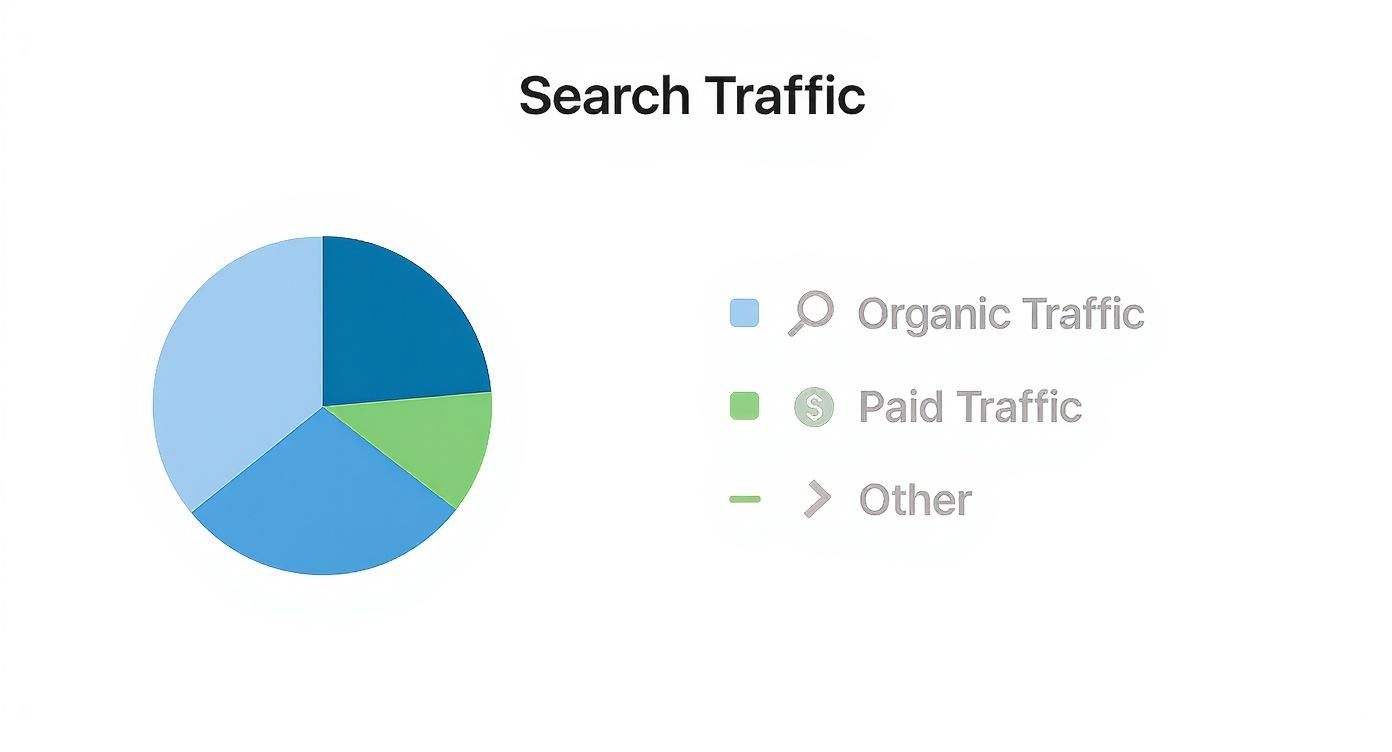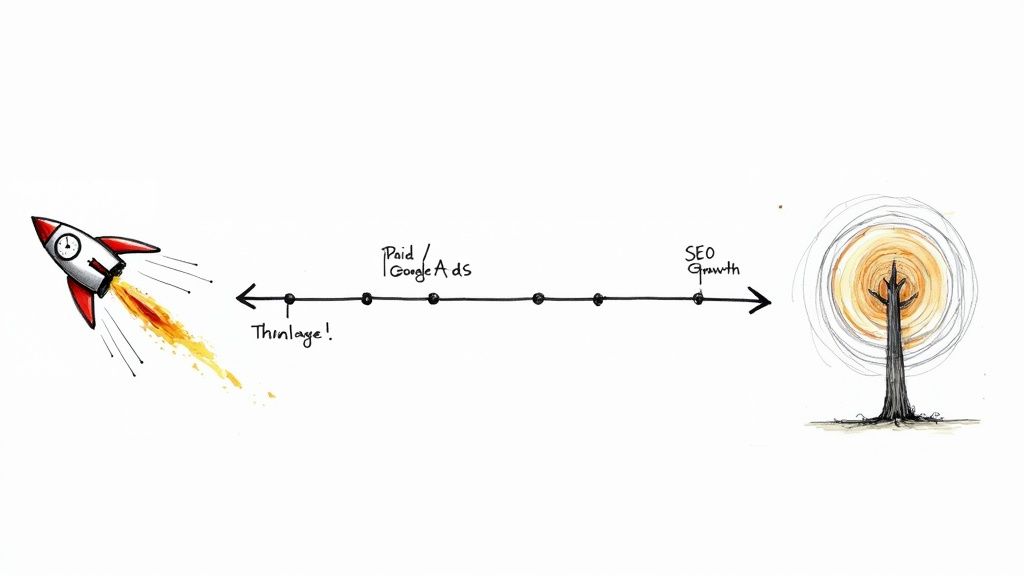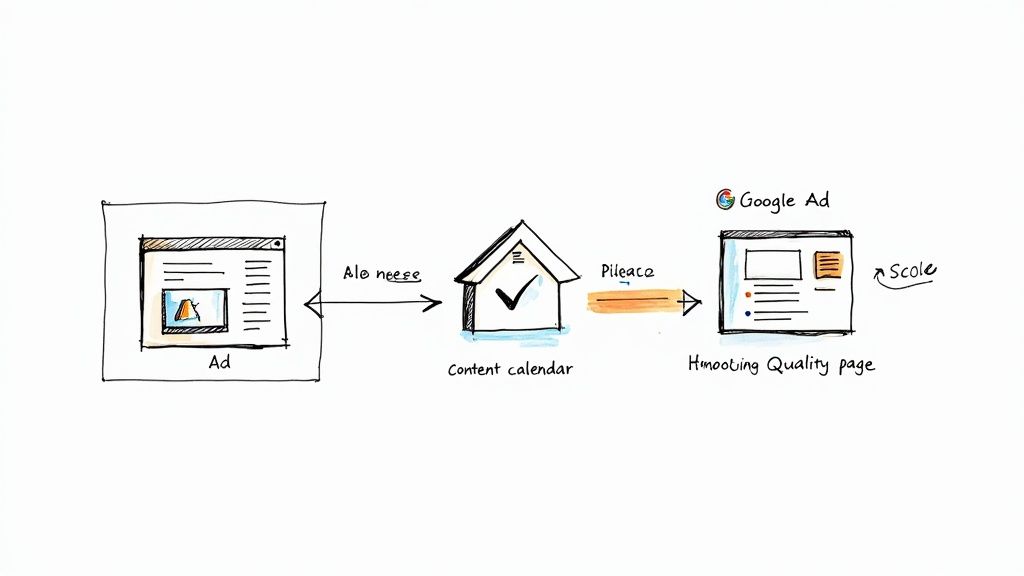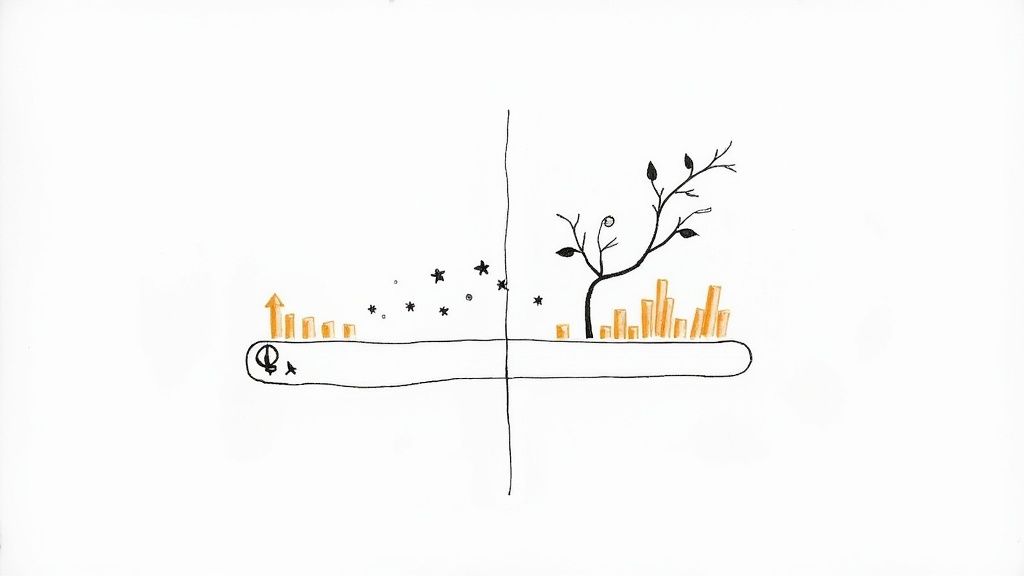At its core, the difference between paid and natural search within the Google ecosystem is simple: paid search is about buying immediate visibility through platforms like Google Ads, while natural search is about earning long-term visibility through strategic optimization. Your decision hinges on a classic trade-off: do you need qualified traffic right now, or are you building a foundation for sustainable, organic growth?
Defining Paid and Natural Search in the Google Ecosystem
To master search marketing, you must understand its two main components. On one side, you have paid search, widely known as Pay-Per-Click (PPC) advertising, which is managed through the Google Ads platform. On the other side is natural search, which is driven by Search Engine Optimization (SEO).
While both aim to drive traffic to your website, their methods, timelines, and strategic value are fundamentally different, especially when viewed through the lens of the Google Ads ecosystem.
What Is Natural Search
Natural search—often called organic search—is the process of optimizing your website to rank higher in Google's unpaid, algorithmic results. You cannot buy your way into these rankings; you earn them by consistently creating high-quality, relevant content and building your site's authority over time.
For a deeper dive, a great resource is this guide on What Is Search Engine Optimization Explained. Think of SEO as building a digital asset. The initial investment of time and resources compounds, creating a steady stream of traffic that doesn't disappear the moment you stop spending money on ads.
What Is Paid Search
Paid search, powered by platforms like Google Ads, allows you to bid on keywords to have your ads appear at the top of the search engine results page (SERP), clearly marked as "Sponsored."
This approach is invaluable for generating immediate traffic and offers unparalleled control. You can launch or pause campaigns in minutes, target specific demographics with precision, and track your return on investment (ROI) with granular detail. It’s like renting a digital billboard on the world's busiest highway—you get a prime spot as long as you pay, making it ideal for promotions, product launches, or generating leads now.
The user perception of these channels is starkly different. Data shows that organic search is a powerhouse, driving about 53.3% of all website traffic. User trust is a key factor, with roughly 70% of people more likely to click on an organic result compared to the 30% who click on paid ads.
| Feature | Paid Search (Google Ads) | Natural Search (SEO) |
|---|---|---|
| Cost Model | Pay-Per-Click (PPC) | No direct cost per click |
| Placement | Top of SERP (Sponsored) | Below paid ads (Organic) |
| Time to Results | Immediate (within hours) | Long-term (months) |
| Sustainability | Stops when you stop paying | Creates a lasting asset |
How Users Interact With Paid vs Natural Results
Understanding the technical differences between paid and natural search is one thing, but the real insights come from analyzing user behavior. This isn't just about placement on the page—it's about user psychology, trust, and intent at the moment of the search.
The most telling metric in this discussion is the click-through rate (CTR). Data consistently shows that users trust and click on organic search results more frequently than paid ads.
This chart illustrates the significant role organic search plays in a typical website's traffic acquisition strategy.

As you can see, organic traffic represents the largest portion for most businesses, highlighting its importance as a primary engine for driving visitors.
The Power Of Trust In Organic Clicks
Think about it: a top organic ranking acts as an implicit endorsement from Google. Users perceive it as a credible, authoritative result because it was earned, not bought. This inherent trust translates directly into more clicks.
For instance, the #1 organic result on Google achieves an average CTR of 27.6%. In contrast, paid ads have a much lower average CTR, underscoring this trust gap. This phenomenon is often referred to as "ad blindness," where users have become conditioned to bypass sponsored listings in search of the "real" results.
The core difference is this: a top organic spot often pulls in a higher volume of clicks because of that earned trust. A well-built Google Ad, however, is designed to capture higher-quality, purchase-ready leads through laser-focused targeting and a clear call to action.
Intent-Driven Clicks In Paid Search
While organic may win in sheer volume, paid search is the undisputed champion for capturing users with high commercial intent. These are individuals who are ready to take immediate action.
Someone searching for "emergency plumber near me" isn't casually browsing. They have an urgent problem and need an immediate solution. This is precisely where a paid ad excels.
The ad's direct messaging, prominent placement, and clear call-to-action align perfectly with the user's urgent, transactional mindset. These users are much further down the sales funnel, making them incredibly valuable. So, while a Google Ad might receive fewer total clicks than a top-ranking blog post, the clicks it does get are often from users primed to convert. This can lead to a much higher conversion rate and, ultimately, a better return on ad spend (ROAS).
To understand how these channels perform, it's helpful to look at their key performance indicators.
Paid vs Natural Search Key Performance Indicators
The table below breaks down the common metrics for paid and natural search, giving you a clearer picture of what success looks like in each channel.
| Metric | Paid Search (Google Ads) | Natural Search (SEO) | Key Insight |
|---|---|---|---|
| Click-Through Rate (CTR) | 1.91% – 3.17% on average | 27.6% for the #1 position | Organic CTR is dramatically higher due to user trust. |
| Conversion Rate | Varies by industry, 4.40% average | Typically lower, often 1-2% | Paid search users often have higher commercial intent. |
| Cost Per Acquisition (CPA) | Directly measurable and optimized | Indirectly measured, spread over time | PPC offers clear, immediate ROI tracking for each conversion. |
| Time to Results | Immediate (within minutes of launch) | Long-term (months to over a year) | PPC delivers instant traffic, while SEO is a long game. |
| Primary Goal | Lead generation, direct sales, ROAS | Brand authority, credibility, consistent traffic | The goals are fundamentally different. PPC is for action; SEO is for authority. |
Ultimately, these numbers show that paid and natural search cannot be measured by the same standards. Each has unique strengths designed to achieve different business objectives.
Speed to Market vs. Long-Term Asset Building
When comparing paid search with natural search, the most significant difference isn't just budget—it's time. Your immediate business goals determine whether you need the instant traffic from a "rented" audience or the steady, compounding growth of an owned asset. The question is: do you need results now, or are you building for the future?

Google Ads for Immediate Impact
For speed, nothing beats paid search with Google Ads. You can set up a campaign in the morning and see traffic, clicks, and leads by the afternoon. This rapid feedback loop is essential in certain business scenarios.
Consider situations where speed is critical:
- New Product Launches: You need to generate buzz and validate market demand—fast.
- Seasonal Promotions: A Black Friday sale or holiday offer has a limited window. You can't wait months for organic rankings to kick in.
- Event Registrations: You have a fixed deadline to drive sign-ups for a webinar or conference.
In these cases, Google Ads acts as a traffic faucet. You pay to jump to the front of the line, placing your message before the right audience at the perfect moment. It’s a direct, measurable, and incredibly fast way to achieve short-term goals.
SEO for Building a Long-Term Asset
Natural search, or SEO, is a different strategic play. It’s not about instant gratification; it’s about systematically building a valuable business asset that delivers returns for years. While a paid ad provides temporary visibility, SEO earns lasting trust and authority from both search engines and your audience.
Think of it as a strategic investment. Every piece of high-quality content you publish and every authoritative backlink you acquire contributes to your website's overall authority. This effort compounds over time, driving a consistent stream of organic traffic that doesn't have a per-click cost.
The key difference is this: paid search rents attention, while natural search builds an asset that owns it. One is a short-term tactic for immediate results, and the other is a long-term strategy for sustainable growth.
Your website's organic presence is like digital real estate. It requires significant upfront effort to build, but once established, it serves as a powerful competitive advantage. This foundation not only brings in predictable traffic but also builds brand credibility in a way ads cannot. The work invested in SEO today becomes the engine that drives future growth, creating a powerful moat that competitors can't easily replicate.
A Realistic Look at Costs and Return on Investment
Let's dispel a common myth: natural search isn't "free," and paid search isn't always a money pit. Both require significant investment. The key difference lies in how you invest and the type of return you can expect.
With Google Ads, the costs are direct and immediate. In a pay-per-click (PPC) model, you pay each time someone clicks your ad. This cost can fluctuate significantly based on keyword competitiveness, your industry, and your ad's Quality Score—a Google metric that assesses ad relevance and landing page quality.
Understanding the True Cost of Each Channel
Natural search, while having no direct cost-per-click, is far from free. It demands a substantial investment of time and resources. The costs are indirect but very real.
- High-Quality Content Creation: Developing authoritative blog posts, guides, and landing pages requires skilled writers, subject matter experts, and strategists.
- Technical Optimization: Ensuring your site is fast, mobile-friendly, and technically sound requires ongoing work from SEO specialists.
- Expert Resources: Whether you hire an in-house team or partner with a marketing agency, genuine SEO expertise comes at a cost.
This fundamental difference in spending directly influences your return on investment (ROI). Google Ads provides a clear, measurable, short-term ROI. You can track exactly how much you spent to acquire a lead, making it ideal for performance-based marketing.
Measuring Long-Term and Short-Term ROI
While paid search delivers quick wins, natural search is about building sustainable, long-term value. The upfront investment in content and technical SEO creates a digital asset that can generate traffic and leads for years, long after the initial work is completed. As your site's authority grows, the value of that asset compounds.
The most important financial takeaway is this: SEO's ROI compounds. The work you do today will continue to generate returns months, or even years, down the line. This effectively drives down your customer acquisition cost over time.
When analyzing where users click, the long-term power of organic search is clear. A deep dive into user behavior reveals that a massive 94% of all clicks on Google go to organic results, with just 6% going to paid ads. While those paid ads are crucial for capturing users ready to buy now, the 94/6 split demonstrates the immense trust and value users place in natural search.
You can learn more about organic vs. paid search performance statistics on digitalsilk.com. To make smart budget decisions, you must calculate the true cost of customer acquisition through both channels and align it with your business goals.
Integrating Google Ads and SEO for Maximum Impact

Here's a secret the best marketers know: the "paid vs. organic search" debate is a false choice. The real victory lies not in choosing one over the other, but in making them work together. By integrating them, you create a dominant presence on the search results page that is far more powerful than either channel could achieve alone.
Think of your Google Ads campaigns as a real-time laboratory for your long-term SEO strategy. The data you get from paid search is an absolute goldmine.
Using Paid Data to Fuel Organic Growth
Google Ads provides instant, granular data on the exact keywords, headlines, and ad copy that drive conversions. This is not theoretical; it's hard, paid-for data reflecting what your audience actually responds to. You can use these insights to eliminate guesswork from your SEO content strategy.
For instance, by reviewing your Google Ads "Search Terms" report, you might discover a specific long-tail keyword with an unexpectedly high conversion rate. This is a clear signal for your content team. It tells them precisely what blog post or landing page to create next to capture that valuable organic traffic.
Suddenly, you’re not just hoping a page will rank; you're making data-driven decisions backed by proven performance metrics.
A strong organic presence directly impacts your paid search performance by improving your Quality Score. Google sees your high-ranking, relevant content as a sign of authority, which can lead to lower ad costs and better ad positions.
This symbiotic relationship creates a powerful feedback loop. Each channel strengthens the other, making your entire search marketing engine more effective and efficient.
A Playbook for a Unified Search Strategy
Harmonizing your paid and organic search efforts is a practical, hands-on process. When your SEO and Google Ads teams share data and insights, you build a more resilient and effective marketing machine.
Here are a few powerful ways to combine your efforts:
- Test Organic Titles with Ad Copy: Run A/B tests in Google Ads on different headlines and descriptions. Once you identify a version with a superior click-through rate, apply that winning copy to the title tag and meta description of the corresponding organic page.
- Prioritize SEO with PPC Conversion Data: Analyze your paid search reports to identify the keywords that generate the most revenue. These high-intent terms should be prioritized in your SEO strategy to build organic authority around your most profitable topics.
- Retarget Organic Visitors with Ads: A user might discover your brand through an informative blog post found in organic search. Use retargeting ads to re-engage them across the web, presenting a specific offer related to the content they read and guiding them deeper into your sales funnel.
Optimizing Your Lead Capture and Management System
Driving targeted traffic from paid and natural search is a critical first step, but it's only half the journey. The ultimate goal is to convert that traffic into qualified leads. This is where your lead capture and management system becomes paramount. A clunky or disconnected process will waste valuable clicks and ad spend, regardless of how well-optimized your campaigns are.
Both paid and organic search require a strategic approach to conversion, but the tactics differ. A winning strategy provides every visitor—whether they clicked an ad or an organic listing—with a clear and seamless path to becoming a lead.
Tailoring Landing Pages for Conversions
For Google Ads, the golden rule is message match. The headline, offer, and tone of your ad must align perfectly with the content on the landing page. If a user clicks an ad for a "50% off winter sale," the landing page must prominently feature that exact same offer. Any disconnect will lead to high bounce rates and wasted ad spend.
Natural search visitors, who often arrive from informational content, require a more nuanced approach. Your calls-to-action (CTAs) should feel like a natural next step, not a hard sell. Instead of pushing a direct sale, offer value, such as a downloadable guide, a webinar signup, or a free tool that is directly related to the article they just read.
The core idea is simple: your lead capture method must match the user's intent. Paid search visitors are ready for a direct offer, while organic visitors are looking for value that builds trust first.
Centralizing and Managing Your Leads
Once you've captured a lead, speed is essential. It doesn't matter if a lead came from a Google Ads form or an ebook download on your blog—they must both be routed into a centralized system instantly. This ensures timely follow-up from your sales team and prevents leads from falling through the cracks.
Tools like Pushmylead are designed for this, automatically sending lead details from your Google Ads campaigns directly to your inbox or CRM. Implementing such a system is a game-changer for streamlining your lead management process.
To further optimize, understanding sales pipeline management best practices provides a framework for converting those leads into closed deals. And if you're looking to expand beyond search, you can also explore effective strategies for lead generation to keep your sales pipeline full.
Your Questions Answered
When deciding between paid and natural search, several practical questions arise. Let's address some of the most common ones to help you determine the best strategy for your business.
I’m a New Business. Should I Use Paid or Natural Search?
You need both, but your focus will shift over time. For a new business, paid search via Google Ads is your best tool for immediate visibility. When your brand is unknown, you can instantly drive traffic, test messaging, and validate offers.
While your ad campaigns are running, begin building your natural search foundation. SEO is a long-term strategy that creates a sustainable asset for your business, ultimately lowering your customer acquisition cost. Use paid search to gain initial traction and leverage the data to inform a smarter, more effective SEO strategy.
My SEO Is Doing Great. Can I Turn Off My Google Ads Now?
You could, but it's often not the best strategic move. Even with top organic rankings, paid ads offer significant advantages. They allow you to dominate the top of the search results page, push competitors further down, and test new keywords or ad copy in hours, not months.
Many of the most successful brands run both simultaneously. They achieve a powerful synergy where the two channels work in concert, boosting overall brand visibility and capturing a larger share of the audience than either could alone.
How Long Until Natural Search Actually Starts Working?
SEO requires patience—it’s a marathon, not a sprint. The timeline depends on factors like your industry's competitiveness, your website's current authority, and the consistency of your efforts.
Generally, you can expect to see initial movement in rankings within 3 to 6 months. However, achieving truly impactful results, such as ranking on the first page for high-value keywords, typically requires 6 to 12 months of consistent, high-quality work.
Stop losing leads because you're manually downloading them from Google Ads. Pushmylead instantly forwards every lead from your campaigns directly to your inbox, so you can follow up faster and close more deals. See how it works at https://www.pushmylead.com.
